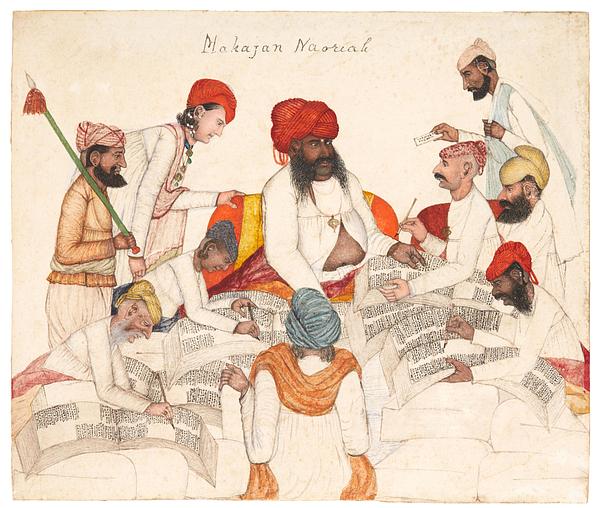The painting has the inscription ’Mahajan Naoriah,’ which can be translated as ’A Nauhria money lender.’ These moneylenders were a group of Hindu merchants who came from the south and primarily worked in Punjab.
There is a slightly simpler version of the museum’s painting with only four people, and it seems to be from the same series as a number of published scenes of everyday life from northern India. It has the inscription “A Hurkurah (dak runner) delivering a letter to Shraffs (Bankers) of Nourie Hindoos.”
[1]A version has also been published of the motif with five men: the money lender, three scribes, and a messenger. This painting has the inscription “Nouriya Sait” and comes from a complete album with 52 illustrations and a colophon that states that it was made by Sani the Draftsman from Jalandhar in Punjab in 1860.
[2] The chronological order of the three works cannot be ascertained, but the painting in the David Collection has the most complex composition and perhaps also the sharpest rendition of the characters.
The central figure in the museum’s painting is the moneylender, and the six men seated around him are his bookkeepers. The runner or messenger is the man with a stick, and the man covered with jewelry might be telling about his arrival or perhaps asking for a loan, like the man on the right with a note in his hand.
The motif belongs to the type of depictions of local life and work that were commissioned in India by visiting Europeans, especially Englishmen, from local artists. In this well-composed scene, however, there is also an unusual element of humor. The protagonist is so robust that his clothing opens over his stomach while he keeps a careful watch on his much thinner employees, who are diligently bent over their thick books.
The painting was made in Punjab, where the European influence was especially noticeable after 1849, when the British assumed the administration of the region. Written in pencil on the back is “Muhammad Sanaullah de Jallandhar 1er dessinateur des Punjab military works.” It cannot be proved that this is the same artist as the “Sani from Jalandhar” mentioned above, but it is probable.
